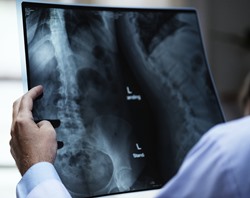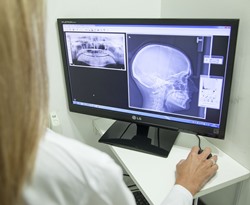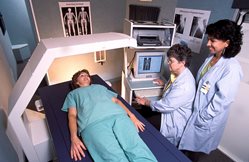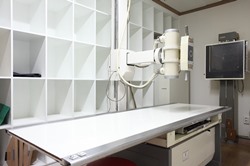How to Find the Right Radiology Technician Course near Cook Minnesota
 So you have made the decision to enroll in an X-ray tech school near Cook MN so you can train to be a radiology technologist. But now that you have made a decision to go into the gratifying field of healthcare, exactly how do you tackle selecting the right school and program to ensure that you will obtain the proper training to become a skilled practitioner? And since the majority of states do mandate that x-ray techs become licensed, depending on where you ultimately practice you might need preparation to pass a licensing test. So it’s important that you investigate each of the X-ray technician schools you are looking at so that you can evaluate each program. Most potential students start by looking for technical schools or colleges that are within commuting distance of their residences. Next, they compare tuition and often settle on the most affordable cost. But while location and cost should be taken into account, there are other critical qualifiers also. For instance, you need to find out whether or not the radiology tech schools are accredited, or if they offer internships. These inquiries and others you must ask the X-ray Tech schools you are evaluating are presented later in this post. But first, let’s discuss what a x-ray technician does and the degrees and training choices that are available.
So you have made the decision to enroll in an X-ray tech school near Cook MN so you can train to be a radiology technologist. But now that you have made a decision to go into the gratifying field of healthcare, exactly how do you tackle selecting the right school and program to ensure that you will obtain the proper training to become a skilled practitioner? And since the majority of states do mandate that x-ray techs become licensed, depending on where you ultimately practice you might need preparation to pass a licensing test. So it’s important that you investigate each of the X-ray technician schools you are looking at so that you can evaluate each program. Most potential students start by looking for technical schools or colleges that are within commuting distance of their residences. Next, they compare tuition and often settle on the most affordable cost. But while location and cost should be taken into account, there are other critical qualifiers also. For instance, you need to find out whether or not the radiology tech schools are accredited, or if they offer internships. These inquiries and others you must ask the X-ray Tech schools you are evaluating are presented later in this post. But first, let’s discuss what a x-ray technician does and the degrees and training choices that are available.
X-Ray Technician Career Description in Cook MN
 There are several professional titles for x-ray techs (technicians or technologists). They may also be called radiologic technicians or technologists, radiology technicians or radiographers. No matter what the name, each has the identical major job description, which is to utilize imaging machines to internally visualize patients for the objective of diagnosis and treatment. A number of radiologic technologists may also provide radiation therapy for treating cancer. Some choose to practice as generalists, while others may choose a specialty, for example mammography. They can work in Cook MN hospitals, clinics, family practices or outpatient diagnostic imaging centers. The imaging technologies that an X-Ray tech may utilize include:
There are several professional titles for x-ray techs (technicians or technologists). They may also be called radiologic technicians or technologists, radiology technicians or radiographers. No matter what the name, each has the identical major job description, which is to utilize imaging machines to internally visualize patients for the objective of diagnosis and treatment. A number of radiologic technologists may also provide radiation therapy for treating cancer. Some choose to practice as generalists, while others may choose a specialty, for example mammography. They can work in Cook MN hospitals, clinics, family practices or outpatient diagnostic imaging centers. The imaging technologies that an X-Ray tech may utilize include:
- Traditional and specialized X-Rays
- Computerized tomography (CT) or “CAT” scans
- Magnetic resonance imaging (MRI)
- Sonography or ultrasound
- Fluoroscopy
Radiographers must maintain their equipment plus frequently assess its performance and safety. They are additionally expected to retain in-depth records of all of their diagnostic procedures. As health practitioners, they are held to a high professional standard and code of conduct.
Click Here For Free Information on X-Ray Tech Schools Near You!
Radiology Tech Degrees Offered near Cook MN
 The standard prerequisite for attending a radiology tech school is to have received a high school diploma or equivalent. Radiologic technologist pupils have the choice to earn either an Associate Degree or a Bachelor’s Degree. An Associate Degree, which is the most prevalent among techs, usually takes 18 months to 2 years to complete depending on the program and course load. A Bachelor’s Degree will take more time at up to 4 years to complete and is more comprehensive in scope. Most students choose a degree major in Radiography, but there are additional related majors that are appropriate as well. Something to consider is that radiographer programs have a practical training or lab component as a component of their curriculum. It can frequently be satisfied by taking part in an externship program which a large number of colleges offer through local clinics and hospitals in Cook MN or their region. Once you have graduated from one of the degree programs, you will need to comply with any certification or licensing requirements in Minnesota or the state you will be working as applicable.
The standard prerequisite for attending a radiology tech school is to have received a high school diploma or equivalent. Radiologic technologist pupils have the choice to earn either an Associate Degree or a Bachelor’s Degree. An Associate Degree, which is the most prevalent among techs, usually takes 18 months to 2 years to complete depending on the program and course load. A Bachelor’s Degree will take more time at up to 4 years to complete and is more comprehensive in scope. Most students choose a degree major in Radiography, but there are additional related majors that are appropriate as well. Something to consider is that radiographer programs have a practical training or lab component as a component of their curriculum. It can frequently be satisfied by taking part in an externship program which a large number of colleges offer through local clinics and hospitals in Cook MN or their region. Once you have graduated from one of the degree programs, you will need to comply with any certification or licensing requirements in Minnesota or the state you will be working as applicable.
Radiologic Technologist Licensing and Certification
When you have graduated from an X-Ray tech school, depending on the state where you will be practicing you might have to be licensed. The majority of states do require licensing, and their criteria differ so contact your state. Currently, all states that do mandate licensure will accept The American Registry of Radiologic Technologists (ARRT) certification exam for the purpose of licensing, but many accept additional options for testing also. A number of states also call for certification as a component of the licensing process, if not it is optional. Having said that, many Cook area employers favor hiring radiology techs that have earned certification so it could improve your career options in and around Cook MN to earn certification. ARRT’s certification program involves graduation from an accepted program as well as a passing score on their comprehensive exam. ARRT also demands re-certification every two years, which may be met with 24 credits of continuing education, or by passing an exam.
Online X-Ray Technician Colleges
 As a component of any degree program, x-ray tech colleges will have practical or lab training included in their curriculum. This is no different for online degree colleges. So although you can still obtain your online degree, a large portion of the training will be fulfilled either in a college lab or in an internship off-campus. Practical training is often conducted in Cook MN hospitals, outpatient clinics or private practices in sponsorship with the schools. But the online section of the training can be attended in the privacy of your Cook home. Students who continue working while earning their degree often discover that the online style of education is far more practical with their active schedules. Plus online schools are often cheaper than conventional options. In addition to lower tuition, expenditures for study materials and commuting may be lessened as well. But just be sure that the online program you enroll in is accredited (more on the benefits of accreditation later). So if you are dedicated enough to learn with this less formalized style of training, then an online school may be the right option for you.
As a component of any degree program, x-ray tech colleges will have practical or lab training included in their curriculum. This is no different for online degree colleges. So although you can still obtain your online degree, a large portion of the training will be fulfilled either in a college lab or in an internship off-campus. Practical training is often conducted in Cook MN hospitals, outpatient clinics or private practices in sponsorship with the schools. But the online section of the training can be attended in the privacy of your Cook home. Students who continue working while earning their degree often discover that the online style of education is far more practical with their active schedules. Plus online schools are often cheaper than conventional options. In addition to lower tuition, expenditures for study materials and commuting may be lessened as well. But just be sure that the online program you enroll in is accredited (more on the benefits of accreditation later). So if you are dedicated enough to learn with this less formalized style of training, then an online school may be the right option for you.
What to Ask Radiology Tech Schools
Once you have chosen the type of degree that you would like to obtain, you can start the process of locating and evaluating x-ray tech colleges near Cook MN. You will also need to decide if you prefer to attend classes online or commute to a local campus. If you opt for the latter, then obviously the location of the school will be important. The price of tuition and supplementary expenses will be a material variable also. But in addition to cost and location, what more should you look at when evaluating colleges? Well, you should ask if the colleges are accredited, and if they provide externship or internship programs. To help you uncover some of these essential details before you make your decision, we have compiled a list of questions that you need to ask the colleges you are reviewing.
Are the X-Ray Technician Schools Accredited? A large number of xray technician colleges have obtained some type of accreditation, whether national or regional. Nevertheless, it’s still crucial to confirm that the school and program are accredited. Among the most highly regarded accrediting agencies in the field of radiology is the Joint Review Committee on Education in Radiologic Technology (JRCERT). Programs earning accreditation from the JRCERT have undergone an extensive evaluation of their instructors and course materials. If the college is online it can also obtain accreditation from the Distance Education and Training Council, which targets distance or online learning. All accrediting agencies should be recognized by the U.S. Department of Education or the Council on Higher Education Accreditation. Besides ensuring a superior education, accreditation will also help in acquiring financial assistance and student loans, which are many times not available for non-accredited programs. Accreditation can also be a pre-requisite for licensing and certification as required. And numerous Cook MN employers will only hire a graduate of an accredited school for entry level openings.
Are Internship Programs Provided? Ask if the xray technician colleges you are assessing have relationships with regional hospitals or clinics for internship programs. Internships are not only a terrific means to receive hands on training in a clinical environment, they are additionally a means to fulfill the clinical training requirement for the majority of programs. As a supplemental benefit, they may help graduates and students form professional connections in the Cook MN healthcare community and help with obtaining employment.
Is Job Placement Help provided? You will undoubtedly want to hit the ground running after graduating, but finding that initial job in Cook MN in a new field can be difficult without assistance. Find out if the radiographer schools you are considering have job assistance programs and what their success rates are. Rapid and high placement rates are an excellent sign that the schools have sizable networks and good relationships with Minnesota healthcare employers. It also substantiates that their students are highly regarded and sought after.
Where is the Program Located? For many students, the school they decide on will need to be within commuting distance of their Cook MN home. Students who have opted to attend classes online naturally will not have to trouble themselves with the location of the campus. However, the availability of local internships will be of importance. Something to consider is that if you decide to enroll in a college that is out of state or even out of your local area, you may be required to pay a higher tuition. State colleges generally charge higher tuitions for out of state residents. And community colleges normally charge a higher tuition to those students that live outside of their districts.
What are the Class Sizes ? Unless you are the kind of person that prefers to sit far in the back of class or get lost in the crowd, you will probably want a small class size. Small classes allow for more individual participation and one-on-one instruction. Ask the Cook MN schools you are researching what the average student to teacher ratio is for their classes. If practical you may prefer to sit in on one or more classes before making your final determination. This will also give you an opportunity to speak with several of the instructors and students to get their perspectives regarding the radiology tech program as well.
Does the School Accommodate your Schedule? And last you need to verify that the radiographer program you finally select can furnish the class schedule you need. This is particularly essential if you choose to continue working while you attend classes. If you need to schedule night or weekend classes in the Cook MN area, confirm that they are offered. If you can only attend part-time, find out if that is an option and how many credit hours or courses you would have to carry. Also, learn what the procedure is for making up any classes that you may miss as a result of work, illness or family obligations.
Top Night X Ray Technician Schools Cook MN
 Selecting the ideal radiology tech college is a critical first step toward launching a rewarding new career providing diagnostic medical services to patients. The suitable radiologic technologist must be in good physical condition. Radiology techs typically stand for the majority of the day and move and at times lift the patient to obtain the proper image. Prospects must also demonstrate a capability to pay strict attention to detail and to observe the safety guidelines designed to protect both the patient and the medical team. Radiology technicians work very closely with patients, other techs as well as the doctors and radiologists. Possessing interpersonal skills is a must in order to have a pleasant work environment and deliver the best available care to patients. You originally came to this website due to an interest in Top Night X Ray Technician Schools and wanting more information on the topic Best Evening Radiology Technician Schools. However, as we have discussed in this report, there are a number of questions that you should ask each program you are reviewing prior to making your ultimate selection. This is equally true whether you enroll in an online school or commute to classes on-campus. By asking the appropriate questions you can analyze and compare each college so you can narrow down your options before making your final choice. And with the appropriate education and your dedication to succeed, you can reach your goal to work as a radiology tech in Cook MN.
Selecting the ideal radiology tech college is a critical first step toward launching a rewarding new career providing diagnostic medical services to patients. The suitable radiologic technologist must be in good physical condition. Radiology techs typically stand for the majority of the day and move and at times lift the patient to obtain the proper image. Prospects must also demonstrate a capability to pay strict attention to detail and to observe the safety guidelines designed to protect both the patient and the medical team. Radiology technicians work very closely with patients, other techs as well as the doctors and radiologists. Possessing interpersonal skills is a must in order to have a pleasant work environment and deliver the best available care to patients. You originally came to this website due to an interest in Top Night X Ray Technician Schools and wanting more information on the topic Best Evening Radiology Technician Schools. However, as we have discussed in this report, there are a number of questions that you should ask each program you are reviewing prior to making your ultimate selection. This is equally true whether you enroll in an online school or commute to classes on-campus. By asking the appropriate questions you can analyze and compare each college so you can narrow down your options before making your final choice. And with the appropriate education and your dedication to succeed, you can reach your goal to work as a radiology tech in Cook MN.
Other Minnesota Diagnostic Locations
Cook, Minnesota
The city of Cook was known initially as Little Fork, because of the river of the same name that runs through the city,[8] later being known as Ashawa, which stands for "by the river or across the river";[8] however its name was changed to its current name on August 1, 1908; at the request of the U.S. Postal Service "because confusion with a village in southern Minnesota named Oshawa". The town was named in honor of Wirth Cook, an owner of the railroad that was constructed through Cook in 1903 and 1904.[8] Cook was incorporated on May 13, 1926.[6]
As of the census[3] of 2010, there were 574 people, 268 households, and 134 families residing in the city. The population density was 226.9 inhabitants per square mile (87.6/km2). There were 306 housing units at an average density of 120.9 per square mile (46.7/km2). The racial makeup of the city was 92.0% White, 0.2% African American, 4.9% Native American, 0.2% Pacific Islander, 0.3% from other races, and 2.4% from two or more races. Hispanic or Latino of any race were 0.9% of the population.
There were 268 households of which 23.1% had children under the age of 18 living with them, 38.1% were married couples living together, 10.4% had a female householder with no husband present, 1.5% had a male householder with no wife present, and 50.0% were non-families. 43.3% of all households were made up of individuals and 20.9% had someone living alone who was 65 years of age or older. The average household size was 2.04 and the average family size was 2.84.
